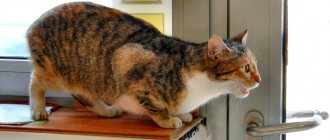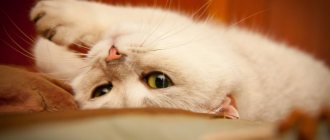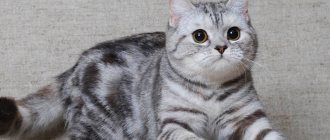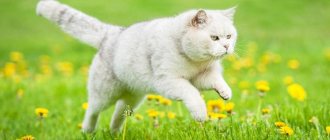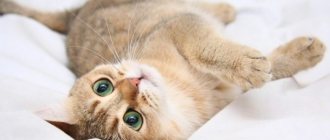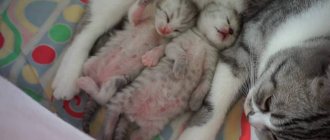What is estrus in a cat?
Estrus, estrus, heat are the names of the state when the female’s body is ready for mating, bearing, and giving birth to offspring. The body undergoes natural endocrine changes caused by the maturation of follicles in the ovaries. The external manifestations, duration, and frequency of this condition are difficult to predict; they depend on various factors. But understanding your pet’s condition will bring undoubted benefits.
Signs and symptoms
Although the symptoms of this process manifest themselves differently in each Murka, you must definitely learn to identify them. The onset is determined by the following characteristic features:
- enlargement of the genitals;
- the appearance of special bloodless discharge;
- increased frequency of urination;
- an increase in the number of licks;
- decreased appetite;
- more affectionate or aggressive behavior;
- frequent attempts to go for a walk;
- characteristic unpleasant sounds.
Whether all symptoms appear simultaneously or only some depends on the individual characteristics of the animal. The pet can roll on the floor, wriggle, throw its tail to the side, howl deep in its throat, make screams, i.e. do everything possible to attract a male and begin reproducing offspring.
For her, this is completely natural behavior, which seems strange and illogical to the owner. There are other manifestations: screaming, constantly meowing, marking territory, walking past the toilet, ignoring the litter tray, eating poorly, not eating anything, sleeping a lot, losing weight, peeing on the bed.
How does the furry beauty feel?
Changes in the endocrine background cause changes in emotions. The condition of the reproductive organs changes. The brain receives signals that significantly change the pet’s behavior. The situation becomes unusual and stressful. The cat begins to worry and feels the need for affection. An increase in stress levels provokes instinctively aggressive behavior, furious meowing. When Murka's puberty proceeds normally, the baby is not in pain, but her anxiety increases noticeably, and she may lose weight due to nervousness.
How often does estrus occur?
Breeders note that the frequency of cycles depends on the breed, more often in temperamental ones, less often in calm ones. The first include the Siamese and Persians, the second - the British and Scots. There are other factors: time of year, childbirth, age, hormonal changes, health status. It is necessary to take into account the individual characteristics of each individual. In cats of the same breed and age, periods of arousal differ markedly.
How long does it last
The duration of estrus is individual for each individual. Usually it lasts only a few days, sometimes it lasts two weeks, twenty days. Felinologists recommend carefully monitoring the process, recording the duration of each rut, and marking the dates on the calendar. Sudden changes in timing indicate trouble. Prolonged sexual activity is a characteristic symptom of problems with the ovaries: cysts, tumors, inflammation. A reduction in the timing of the rut occurs with hormonal problems, expressed in thyroid pathologies, abnormal development of the ovaries.
Seasonality of the reproductive cycle
The time of year affects the frequency of heat in cats. In spring, summer, and autumn, the desire to mate increases, in winter it decreases. It is necessary to take into account the conditions of detention; permanent residence in a warm house blurs the lines between seasons; the female is ready to mate regardless of the season. This is an individual moment. One Murka expresses a desire to mate at the very beginning of spring, the other - closer to the beginning of summer. With age, the seasonality of the reproductive cycle changes. If Murka is healthy, there is no need to worry.
Frequency of estrus
How many times and exactly when the process starts depends on:
- childbirth and feeding, after which half a year or less may pass until the next active phase;
- death of kittens or early weaning after birth, which reduces the break until the next active phase;
- age, the desire to mate becomes less as the female ages.
One heat cycle every three months, i.e. four per year is considered the average norm. There are cats that are ready to mate every month or more often; for some, one date with a male every six months is enough.
If there has been mating, the desired pregnancy has occurred, estrus will stop for the duration of gestation, i.e. for two months or a little more. The next active phase occurs 3-5 months after birth or earlier if the offspring was stillborn.
Developments
Let’s say a person hasn’t thought about this possibility, but he also doesn’t have much desire to have kittens. This is correct, considering how difficult it is today to place furry beauties, especially if they do not have a pedigree. Let's now count how many times a year a cat goes into heat.
The classic option is every three months. That is, they are able to bear offspring 3-4 times a year. Typically, this pattern is observed in mated animals. If she hasn't walked yet, then the frequency may be higher. Here everything is also individual: for some once a month, for others every two weeks. Of course, animals react to them differently. Some very vigorously express their desire to procreate, others behave more calmly. But in any case, not everyone can endure antics several times a month.
Cat's first heat
This is a special time. The pet's body changes, sensations appear that she has not experienced before, Murka needs care and attention. It is difficult to accurately calculate the beginning of a special time. When your pet turns six months old, it is necessary to carefully “try on” changes in behavior for signs of maturation in order to identify the onset of natural maturation processes and recognize early symptoms of possible diseases.
When does the first heat start?
The time of onset of the first estrus in a cat varies widely: from six to sixteen months. There are “early” babies who mature by four months, although such early estrus indicates the presence of a developmental pathology, the onset of the disease. If a one-and-a-half-year-old beauty does not experience estrus, a veterinarian’s consultation is necessary. A long process of puberty is a sign of developing problems that cannot be ignored.
Features of the first rut
The optimal age for the first rut is approximately 10 months; mating at this time will allow the mustachioed beauty to have offspring by a year or a little later. The body is already mature enough to withstand the stress associated with childbirth. It is important to have a general idea: when the cat’s first sexual estrus began and how it proceeded. During early rutting, probable pathologies are identified and treatment is begun. The decision to sterilize is also made at this stage.
What is happening to Murka at this time?
Experts divide the rut into four main periods. It is difficult to see clear boundaries between them, but knowing how to understand when your pet is having sexual activity will be useful. The owners will better understand the feelings of the pet and will be able to choose the optimal time for mating. This will increase the cat's chances of starting pregnancy at the right time. The defining moment is the exact determination of the first day of the cycle.
Proestrus
The initial stage lasts from a day to four, often lasting two days. The pet eats less, there is slight discharge and swelling of the genitals. The cat becomes affectionate, reacts aggressively to the cat or remains indifferent. The process has just begun, the pet is not ready for mating. It is worth assessing what color the discharge is during the rut. They should be scanty, transparent, odorless.
Estrus
This is the active phase, suitable for mating, and lasts five to ten days. Now it becomes clear what this process looks like in a cat. Now characterized by increased hormonal levels and heavy discharge. The cat's behavior acquires a pronounced desire to mate. She arches, rolls on the floor, wriggles, throws her tail, and makes unusual body movements. The pet does not purr, but rather screams.
The inability to release sexual energy during mating can cause mustachioed beauties extremely unpleasant physical sensations, which is why they scream. Any disciplinary measures will increase stress; neither persuasion nor punishment will change the endocrine background of the pet. If estrus is asymptomatic, behavior remains calm, and there is a high probability of problems in the gynecological area.
Interestrus
It is called post-estrus or metestrus. Depending on whether there was mating, here are the options for the development of events:
- fertilization has occurred, pregnancy has occurred, kittens will appear in ten weeks;
- after mating, fertilization did not occur, a false pregnancy occurred, lasting thirty to forty days, then the next rutting period will begin;
- there was no mating, arousal will gradually decrease over a period of two days to two weeks.
In this phase, the manifestation of aggression towards the male is considered natural. New hormonal changes associated with a return to normal or the development of pregnancy again affect the animal's behavior. The pet begins to calm down and does not let the cat near.
Anestrus
The resting phase from metestrus to the next estrus. In cats that are regularly bred after pregnancy or childbirth, this period may be longer than in a pet that has gone through an empty heat. Aneestrus lasts several weeks or months. Felinologists note that numerous rutting periods that do not end with fertilization do not bring benefit to the cat. The likelihood of developing a number of diseases increases. It is necessary to decide now how to stop or interrupt the next hunt.
Natural phenomenon
Don't be angry with your pet. If her mood changes, she stops listening and begins to bother you, this is not at all because she is acting out of spite. The reproductive instinct is simply stronger than the best training. You need to prepare in advance for the cat's growing up period, because the owner must not only have knowledge of what his pet looks like during heat, but also be ready to help her transition to adulthood. Many people think that cats cause problems. But just imagine how many times a year a cat goes into heat, and the behavior is not much different from what a male exhibits.
How to behave as an owner
Mating is a natural step for a current female, but it is not always possible. It's a bad idea to breed a female cat during her first heat. Simple methods and techniques will help ease the baby’s suffering:
- distract with favorite or new toys;
- pick up, stroke, massage, soothe with gentle words;
- feed frequently in smaller portions;
- reduce room lighting;
- use sedatives recommended by your veterinarian;
- invite an active neutered male for mating.
Some owners independently stimulate the cat to help the pet get through a difficult period if the cat does not want the cat or is unavailable. First you need to put a glove on your hand and prepare a clean cotton swab. You need to stroke the cat, which is in a state of rutting, on the back, and gently grab it by the withers.
The vulva is then gently stroked until the vagina begins to pulsate and the tail is pulled to the side. Now you can slowly insert a cotton swab or other suitable object inside. Stimulation is carried out until discharge occurs. The procedure is repeated several times.
If there are cats in the house, and mating is not planned, the current female must be isolated and harmless folk remedies used to calm her down. The bed should be placed next to a radiator or other heat source, and a warm heating pad should be placed. Frequent bathing helps relieve tension. You need to wash your pet carefully. If Murka does not like water, the irritation will not subside, but will intensify. Sometimes catnip or decoctions of soothing herbs: lemon balm, chamomile give results.
There are herbal soothing drops and tablets to stop Murka from screaming:
- Stop Stress;
- Cat Baiyun;
- Anti-stress.
They have a mild effect and do not affect the hormonal state of the animal. There are relatively safe means in the first aid kit to calm Murka down. Suprastin is given at the rate of a quarter of a tablet per five kilograms of weight, once a day towards night, for three days.
Suprastin suppresses the psyche of fluffies; it cannot be considered as a replacement for hormonal therapy or sterilization. The medicine is prescribed as a temporary measure after childbirth to delay the onset of a new pregnancy.
On specialized forums there are reviews, photos, prices for medicines, recommendations on what else can be used for a pet during estrus. If she starts peeing anywhere, marking her territory, she needs to use special underpants.
Signs
In fact, everything is not clear here either. The period of estrus in cats can vary depending on the breed, age, and individual characteristics. This can also be said about the nature of its course. But we will try to summarize all the features so that the owner understands what we are talking about.
- By analogy with dogs, everyone expects bloody discharge. But cats don’t have them. Lubricant comes out of the vagina, swelling of the genitals is observed, and the cat actively licks them.
- Mood changes. Here, too, not everything is clear. The animal may show aggression or become very affectionate, rubbing against its legs, purring.
- Try stroking the sacral area. No matter how often cats go into heat, they react to it in much the same way. Namely, they raise their tail and move their paws.
- There is frequent urination. Some cats even mark their territory.
- The animal actively begins to look for a way out of the house. Therefore, carefully close the vents, windows and doors. She is driven by the instinct of reproduction, but it is you who are responsible for her life and health.
- Appetite often disappears. The animal may not eat until the end of estrus.
- Makes unusual sounds, from purring to howling. They are needed to summon cats from all over the area and cause major discomfort.
Deviations from the norm
The owner needs to carefully monitor the seasonality, duration, and nature of estrus in order to record anomalies. A long absence of the active phase, its frequent occurrence, pain, sluggish response to treatment, yellowish discharge with an unpleasant odor, bloody inclusions indicate endocrine disruption and more serious health problems. If the first rut does not occur for too long, when estrus lasts longer than two weeks, consultation with a veterinarian is required. Signs of ill health must be combated with means recommended by specialists.
Prolonged heat
In this state, the duration of the physiological phases of the process increases. The continuous rut lasts more than two weeks, causing discomfort to the pet. A characteristic feature is the continued appearance of mucous discharge, accompanied by manifestations of aggression towards the male. Mating does not occur, fertilization does not occur, the mustachioed beauty remains excited. Prolonged stress makes the situation worse.
Anaphrodisia
This is the name for the condition of a fluffy beauty who is of childbearing age, but does not show any signs of sexual desire. Anaphrodisia (acyclia) is a characteristic sign of delayed puberty. If the female is not intended for breeding purebred offspring, she may not need treatment. The veterinarian examines the animal to rule out hyperfunction of the thyroid gland or adenohypophysis. If pregnancy is necessary, combination therapy with follicle-stimulating hormones is carried out: choriogonadotropin, folliculin, estrone.
False pregnancy
Only a veterinarian can accurately diagnose this condition. It is characterized by the same symptoms as for normal pregnancy:
- increased appetite;
- increased thirst;
- finding a secluded place;
- increased attention to small soft objects;
- swelling of the mammary glands;
- increase in abdominal size.
The problem is considered psychological and is seen as the result of prolonged stress. The sad result is purulent mastitis and similar diseases. Sphynx cats have an innate tendency to show signs of false pregnancy.
Empty heat
Lack of fertilization is not considered a normal condition. If your pet does not become pregnant, the body experiences unwanted hormonal stress. The situation is complicated by the substances that caring owners give to calm the cat at this time. In the future, there is a high probability of developing dangerous diseases: mastitis, hyperplasia, cancer, ovarian cysts, polycystic disease, endometritis, purulent inflammation, etc. If you do not plan to get offspring from a cat, timely sterilization will be a choice in favor of her health.
Frequent heats
The average norm is two to four rutting periods per year, although much depends on temperament, breed, and genetic characteristics. It happens that the re-rut occurs too often, literally every week or two. This dangerous condition cannot be ignored. If mating is not planned, you need to show the animal to a veterinarian. Perhaps this is a manifestation of a serious gynecological disease, for example, polycystic disease. Treatment with hormones can be effective. If the problem is not resolved, castration is the next appropriate step.
Bloody issues
The appearance of blood in mucous secretions indicates the presence of a serious pathology. It is impossible to determine the cause “by eye”; a serious examination by an experienced veterinarian is necessary: standard tests, histology, cytology, ultrasound, studies, the decision of which is made by a specialist. Some diseases develop rapidly. If you have bloody discharge, the most sensible step is to visit the clinic immediately.
If the cat is involved in breeding
If the animal has the opportunity to reproduce regularly, then the frequency of estrus will be extended. Usually veterinarians say that then it occurs once every 5-6 months. A cat should not give birth more often; this will have a negative impact on its health. Caring breeders do not allow more than once a year.
But the estrus period for cats is individual. Sometimes the furry beauty has not yet emptied her nest, the kittens are only a month old, and she is already in heat. In this case, you need to carefully monitor her and prevent mating. Pregnancy, breastfeeding and conceiving again is a triple blow to her health.
Reasons for lack of estrus
Among the reasons for a long-term lack of desire to mate are:
- predisposition caused by genetic breed characteristics;
- dysfunction of the thyroid gland;
- endocrine shift;
- pathological condition of the ovaries;
- hermaphroditism, etc.
There are emotional factors that cause sexual dysfunction. Lack of hunting is observed in individuals that are kept indoors, do not have contact with other representatives of their species, and do not observe normal sexual behavior.
Purebred females over one and a half years old who are involved in breeding require treatment to restore the normal functioning of the reproductive organs. Pets kept for pleasure do not need such treatment. The veterinarian will examine the pet; if other pathologies do not appear, treatment is not necessary. Periodic preventive examinations will be required.
Sexual desire in a sterilized cat
The surgical procedure used to prevent pregnancy is commonly called sterilization. In practice, the animal undergoes one of three operations:
- tubal occlusion: tubal ligation;
- oophorectomy - removal of the ovaries;
- Ovariohysterectomy - simultaneous removal of the uterus and ovaries.
Tubal ligation does not stop the maturation of the follicles, creating an obstacle to the fertilized egg entering the uterus. The hormonal background does not undergo changes, the occurrence of heat in a pet that has been sterilized by tubal ligation is the norm. The cessation of sexual activity occurs as a result of oophorectomy or ovariohysterectomy. These two procedures protect the pet well from inflammation of the uterus, ovarian cancer, polycystic disease, and similar diseases.
Is it possible to sterilize a cat at this time?
Sterilization during the rutting period is strictly prohibited. A gross change in the development of hormonal processes will negatively affect the health of any animal. The procedure is recommended two weeks before or two weeks after the active phase.
Kittens predisposed to the development of mammary gland cancer are sterilized before the first heat, the permissible age is six months or a little more, weight is more than three kilograms. The rest are sterilized after the first heat. The signs are not always obvious; there is a danger of missing the deadline and performing the operation when the pet is in a state of activity, which is strictly contraindicated.
Use of hormone-based medications
Mustachioed pets cope with this difficult time in different ways. Some need a little affection and attention to survive this period, while others suffer from unsatisfied desire, despite the efforts of their owners. If the usual methods of calming down are powerless, you will have to turn to special means, tablets, drops, options that help relieve tension. When mating is not planned, sterilization is the right option.
The principle of operation of drugs of this type
Only hormones, natural or synthesized, can effectively influence the onset of sexual heat. Progesterone enters the body during pregnancy. A dose of progestin preparations administered during the rest period suppresses the effect of follicle-stimulating hormone. Estrogen, which provokes sexual desire, does not enter the blood, and the period of sexual desire is blocked. If hormonal medications are used incorrectly, your pet may die.
Types of drugs
Hormonal preparations of this type are available in tablet form, as drops for internal use or application to the withers. An effective, high-quality product contains a complex of hormones. Veterinarians often prescribe the following:
- “Stop-intim”, drops based on megestrol acetate, a synthetic analogue of progesterol, given orally with a treat, sugar or forcibly;
- “Contrasex”, drops, tablets containing synthetic hormones acetomepregenol, ethinyl estradiol;
- “Gestrenol” is a complex biohormonal preparation in the form of drops and tablets;
- “Sex barrier” - mepregenol acetate plus ethinyl estradiol, liquid, tablets;
- “Ovostop” is a complex of megestrol, proroxan, melatonin, drops on the withers.
Such drugs cannot be considered harmless drugs. Before starting use, you must carefully read the instructions.
Features of application
For health and safety reasons, it is best to consult your veterinarian first. Hormones are prescribed only to healthy animals; they are administered in strict accordance with the instructions. Progestins have many contraindications; a non-specialist cannot determine them by eye. You should not skip a dose or increase the dose to compensate for the missed dose of medication.
Non-extended-release medications must be taken for the entire prescribed period. Determining the dosage is the task of the veterinarian. Spontaneous use of hormonal contraceptives is unacceptable. It is forbidden to use progestin preparations during sexual heat, this is after the end of the active phase.
Hormones do not replace the sterilization procedure; their purpose is:
- delay the onset of the active phase if pregnancy is contraindicated for your pet for some time, after recent childbirth, cesarean section, gynecological problems;
- adjust the mating time, for example, until a suitable male is found;
- prevent pregnancy if immediate sterilization is contraindicated.
Within 24 hours after an unwanted mating, progestins can prevent unplanned pregnancy.
How to determine the right day
Taking hormonal drugs in the active phase will be a disaster for the cat. The third day of the period is considered critical; the process enters the active phase. Many females experience a quiet, mild estrus, which begins almost asymptomatically.
An inexperienced owner may not pay attention to the signs: Murka becomes thoughtful and affectionate. An important point is the behavior when stroking the sacrum. The pet characteristically arches, throws back its tail, sexual activity is in full swing, progestins cannot be given. When there is no such reaction, the use of the medicine is acceptable.
Hormonal injections
The veterinarian sometimes recommends a hormone injection using a long-acting drug. Usually it is Covinan or Depo-Provera. The first is based on proligestone (synthetic progesterone), a steroid that inhibits the processes in the animal’s body that cause sexual desire, reducing the concentration of luteinizing hormone.
After discontinuation of the drug, fertility is restored. Injections are given according to a strict schedule to minimize side effects. If diarrhea, vomiting, or undesirable effects occur, the drug is discontinued.
Depo-Provera was originally developed as a female contraceptive, but has found use in veterinary medicine. The basis of the drug is medroxyprogesterone, a synthetic substance that can suppress ovulation. Available in the form of suspension and tablets. These medications should absolutely not be used during estrus. At the end of use, the ability to produce offspring is restored.
Memo for the owner
As the animal enters sexual maturity, we have new concerns. You need to know not only how long the cat’s first heat lasts, but also about the physiological characteristics of your pet. In particular, that it is forbidden to bring a cat to a young cat. Individuals no younger than one year old are allowed to reproduce. Early labor can be too difficult and even cause the death of the mother.
If mating has taken place, consult your veterinarian. You can carry out sterilization and solve the problem with this and subsequent offspring. If the cat is valuable for breeding, then the pregnancy must be monitored using an ultrasound, and it is advisable to invite a veterinarian to the birth (in case of complications).
Sterilization is the right choice
This is the most humane choice for a furry beauty who is no longer involved in breeding. It is recommended to sterilize a Murka taken into a home for love before her first heat. Cats are not people. They do not have the choice “to give birth or not to give birth.” Cat reality: “give birth or suffer.”
Empty estrus and thoughtless use of hormonal drugs lead to painful diseases that require expensive treatment. If your pet survives after medical procedures, sterilization is still inevitable.
Modern sterilization is a gentle procedure performed using laparoscopic equipment. The cost is moderate. One or more small cuts will be required. After a short recovery period, the pet will continue to live a full life, bringing joy to the home.
Sterilization increases the life expectancy of a pet by five to ten years. Murka will be able to calmly walk everywhere, and the owners will no longer worry about unwanted kittens.
Mistakes of owners in methods of calming down
The pet behaves unusually at this time, the owner needs to react correctly. You cannot respond to aggression with punishment or try to silence it with a shout. It is better to leave an irritated animal alone and give it time to recover.
Murka must have her own place, it is necessary to provide her with the opportunity to retire, especially if there is a dog or other pets in the house. You need to react in a similar way to any changes in behavior, for example, if she shits anywhere. Gradually, the body will return to normal, the correct habits will be restored.
Some people mistakenly consider valerian to be a sedative, but for fluffies it is a stimulant that increases sexual desire. Contact with valerian is undesirable during the rest period; during the active phase, the pathogen will cause harm; the drug must be removed out of reach.
You should not try to use Corvalol, Valocordin, glycine, motherwort, or “human” medications to calm the baby, without a veterinarian’s prescription; special feline homeopathy is preferable.
Catnip is used as a sedative, but it is a pathogen that acts much more mildly than valerian. Suitable for correcting the behavior of cats; use the product carefully during sexual activity. Sometimes there is a need to vaccinate, i.e. vaccinate or worm the cat during estrus. There are no significant contraindications for this, but permission from a veterinarian is required.
A terrible mistake would be uncontrolled, too long-term use of hormonal drugs. Using alternative sedatives is a temporary measure. Even if it is possible to relieve the symptoms, complications from empty heats are almost inevitable. The cat must be regularly mated with a male cat or sterilized.


